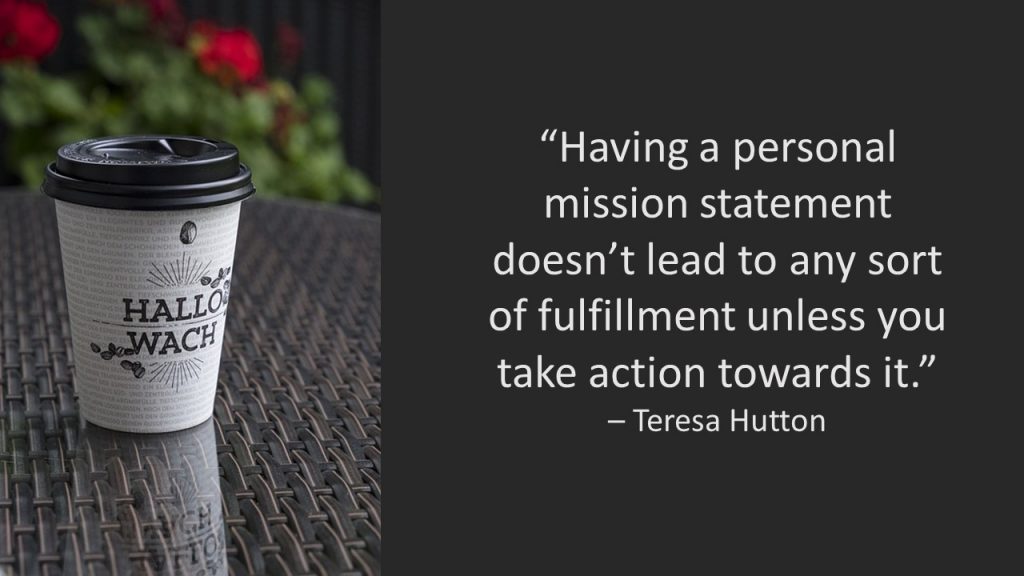“Your manager kicked you out of his office?” Nicole asked. Jacob shook his head. He slouched in his seat at the small table and took a sip of coffee. Too hot and unusually bitter. “I want to make things safer. Why is that not important to him?”
They were discussing Jacob taking action towards his mission statement:
I want to make automated machinery safer to use and maintain through design and education.
Nicole smiled empathetically and thought about how she wished she had a mentor at Jacob’s age when faced with a similar challenge. In an even tone she asked, “What is on your manager’s plate these days?”
Jacob looked at her quizzically. Since this was the first time he thought about it, he paused for a minute before answering. Nicole quietly enjoyed her coffee. Jacob listed his observations: approving his timesheet, running the weekly status meeting, and attending a lot of other meetings. His manager was not at his desk often or for long stretches of time, and even more so lately.
As an engineer-turned-manager herself, Nicole understood Jacob’s perspective and the responsibilities of his manager. She explained that, for the most part, meetings served the purpose of updating status, setting direction, and making tactical decisions. Just like engineers have goals – work product goals and career/personal goals, so do managers. They are concerned with budgets, schedules, and planning. Team members who help their manager meet their goals and be successful tend to be more successful themselves.
Jacob shifted his unfocused stare from his coffee cup to look at Nicole intently. He said, “If I can present my ideas in a way that support my manager’s goals or an even broader company initiative that he can support, I have a better chance at being heard.”
Well-stated.
“Thanks for meeting with me on short notice,” Jacob said. Having been a neighbor of Jacob’s family for years and watching him grow up, Nicole was grateful to have the opportunity to mentor a younger professional who she knew had high potential.
“To a successful safety initiative,” Nicole toasted. They delicately clinked their paper coffee cups.
The next morning Jacob arrived a few minutes early to collect his thoughts and prepare his materials for the do-over meeting that his manager graciously granted. His heart beat a bit fast for just walking to a conference room. He drew in a few deep breaths while connecting his laptop to the screen.
Jacob’s manager arrived, took a seat, and nodded for him to proceed. Jacob walked him through his ideas that he had worked on the evening before. The presentation started with why the safety initiative was important to the company’s value of Safety First. Not having time to do extensive research, he talked about the safety incidents and situations that he was personally aware of. His manager’s laptop was closed, his phone was nowhere in sight, and his full attention was on Jacob’s presentation.
Jacob proceeded to walk through the proposal: interviews with the people on the manufacturing floor, creating a safety scorecard to measure progress, and criteria on how to sort associated projects and tasks based on impact, effort and cost. Having only an evening to prepare it was a plan to plan, but as he talked about each component his manager nodded.
Jacob concluded by addressing a question he predicted his manager would have: where would we find the time to work on this initiative? Jacob proposed that once he concluded his design work on the current project he could delegate the task of managing the testing to the junior engineer on the team, who he had been mentoring. Jacob surprised himself when he finished as the time went by fast. His manager contemplated quietly, looking at the final slide on the screen. Jacob’s instinct was to start talking, offering other suggestions if these weren’t appropriate, or proposing to do more research. Instead he also remained quiet.
Smart decision.
Jacob’s manager finally explained that he didn’t grasp what Jacob was getting at yesterday, but with this presentation he understood the intent and direction. Jacob reflected on his discussion from the day before and understood how the mishmash of information was confusing, even though he presented it with excitement and passion.
Jacob couldn’t help by smile wide and he thanked his manager again for the do-over. Jacob savored his coffee that morning.
But was this the best case or worst-case outcome? What if the director didn’t agree? Would he be sinking himself and his manager? Jacob pushed the thoughts out of his mind by concentrating on his work at hand. He might even hear feedback by the end of the day. He had no other option than to wait.
tl;dr
Having a personal mission statement doesn’t lead to any sort of fulfillment unless you take action towards it. Be thoughtful and strategic in the action you do take.
engineer your life
- If you missed the start of the story, read it here
- Determine one action you can take in the direction of your mission statement. Small steps are great!
- If attempting to influence another, put yourself in the shoes of that person. Do your best to anticipate the questions they may have.
- Consider being a mentor. There’s always someone with less experience or different experience who can benefit from what you know.

Image by Bruno /Germany from Pixabay